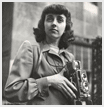During her career, Bubley used a variety of cameras including Rolleiflex, Leica, Contax, and Nikon. In the early 1950s she began to rely more on 35mm cameras. The last camera she purchased, in 1997, was a Nikon N70 with a 35mm-105mm Nikkor lens and a speed light.
Although she preferred black and white to color, Bubley shot a great deal of color for her later assignments, and sometimes printed the images in black and white. She preferred natural light to artificial, when practical. People, especially ordinary people going about their usual routines, were Bubley's favorite subjects. She said she enjoyed taking pictures of children, especially naughty ones. Bubley was generally quiet and unobtrusive, which put her subjects at ease. On occasion, however, she surprised and amused younger subjects when she climbed furniture and bookshelves to get the angle she wanted. Bubley's images are compelling, simultaneously realistic and artistic. They capture the essence of the moment, while always remaining respectful of her subjects.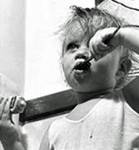
In 1944, Minicam magazine interviewed Bubley on how she photographed the Wenk family in their home. She accomplished the lighting with two photofloods using number two bulbs in dishpan reflectors. Most of the time one photoflood was sufficient, but she used the second when the surrounding objects did not reflect enough light to fill in the shadows. Most of the pictures with flood lights were exposed at 1/50 at f/8. With flash, she used number 5 bulbs in midget reflectors and an exposure of 1/100 at f/16. Her camera was a twin lens reflex and the film was super XX.
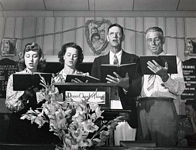 In a 1947 Minicam article, Bubley talked about taking pictures in Tomball, Texas, for Standard Oil of New Jersey. She relied on two cameras: an Ikoflex III and a Linhof Technika with a 5 1/4 inch f/4.5 Zeiss Tessar lens. For pictures of people or subjects that were in motion, she used the Ikoflex. When she shot with the Linhof, she used a tripod whenever practical. She selected Eastman Super XX film for both cameras, and she used flash when necessary. Her favorite flash set up was one light used off the camera with a reflector coming from the direction a light might normally come from, and a bulb without a reflector at the camera for a fill in.
In a 1947 Minicam article, Bubley talked about taking pictures in Tomball, Texas, for Standard Oil of New Jersey. She relied on two cameras: an Ikoflex III and a Linhof Technika with a 5 1/4 inch f/4.5 Zeiss Tessar lens. For pictures of people or subjects that were in motion, she used the Ikoflex. When she shot with the Linhof, she used a tripod whenever practical. She selected Eastman Super XX film for both cameras, and she used flash when necessary. Her favorite flash set up was one light used off the camera with a reflector coming from the direction a light might normally come from, and a bulb without a reflector at the camera for a fill in.
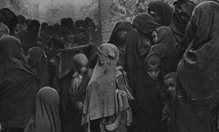 Photographing in Morocco on assignment for UNICEF in 1953, Bubley made the image "Moroccan Peasants" with a Contax II camera and a 35-mm Nikkor f/2 lens. The exposure was made on Super-XX film at 1/25 second, using existing daylight. The image was awarded First Prize in the International Black-and-White division of Photography Magazine's photo contest in 1954. Bubley was the first woman to win that award.
Photographing in Morocco on assignment for UNICEF in 1953, Bubley made the image "Moroccan Peasants" with a Contax II camera and a 35-mm Nikkor f/2 lens. The exposure was made on Super-XX film at 1/25 second, using existing daylight. The image was awarded First Prize in the International Black-and-White division of Photography Magazine's photo contest in 1954. Bubley was the first woman to win that award.
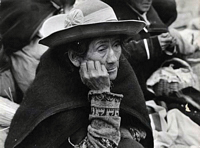 In a 1957 interview for the New York Herald Tribune, Bubley talked about her recent assignment for Pepsi-Cola in Central and South America. She had two M-3 Leicas and two Rolleiflexes. The 35mm cameras were equipped with 35mm, 50mm, and several telephoto lenses. She used three films: Tri-X, Plus-X, and Verichrome-Pan at 100, developed in D-76 for fourteen minutes at 70 degrees. She preferred to develop her own film, but that was not always possible.
In a 1957 interview for the New York Herald Tribune, Bubley talked about her recent assignment for Pepsi-Cola in Central and South America. She had two M-3 Leicas and two Rolleiflexes. The 35mm cameras were equipped with 35mm, 50mm, and several telephoto lenses. She used three films: Tri-X, Plus-X, and Verichrome-Pan at 100, developed in D-76 for fourteen minutes at 70 degrees. She preferred to develop her own film, but that was not always possible.
 For her book A Mysterious Presence: Macrophotography of Plants, published in 1979, Bubley used a Nikon F camera and 55mm f/3.5 Micro Nikkor lens. When needed, she employed Nikon F Extension Rings and a Nikon Bellows 2, sometimes together for extremely close work. She used Tri X film rated at ASA 600, exposed according to meter readings and developed in Acufine for 5 1/2 minutes at 68 degrees. Except for the daylight shots, she used a sturdy tripod. Because of vibrations from the street, she used indoor exposure times between 1/30 and 1/60, and apertures from f/5.6 to f/16. For lighting she used two small spots and two photofloods. Due to the heat of the lights, the sprouting seeds were photographed in water. She had three basic ways of positioning the lights. (1) She positioned the subject on the glass and lighted directly from below with the floods, sometimes using the spots for accents. (2) The spots fell directly on the subject, and the flood bounced from the wall or ceiling for softening fill in. (3) She positioned the subject on the glass, and directed the floods at a white paper background on the floor or in back of the subject; sometimes she used the spots for highlighting.
For her book A Mysterious Presence: Macrophotography of Plants, published in 1979, Bubley used a Nikon F camera and 55mm f/3.5 Micro Nikkor lens. When needed, she employed Nikon F Extension Rings and a Nikon Bellows 2, sometimes together for extremely close work. She used Tri X film rated at ASA 600, exposed according to meter readings and developed in Acufine for 5 1/2 minutes at 68 degrees. Except for the daylight shots, she used a sturdy tripod. Because of vibrations from the street, she used indoor exposure times between 1/30 and 1/60, and apertures from f/5.6 to f/16. For lighting she used two small spots and two photofloods. Due to the heat of the lights, the sprouting seeds were photographed in water. She had three basic ways of positioning the lights. (1) She positioned the subject on the glass and lighted directly from below with the floods, sometimes using the spots for accents. (2) The spots fell directly on the subject, and the flood bounced from the wall or ceiling for softening fill in. (3) She positioned the subject on the glass, and directed the floods at a white paper background on the floor or in back of the subject; sometimes she used the spots for highlighting.

